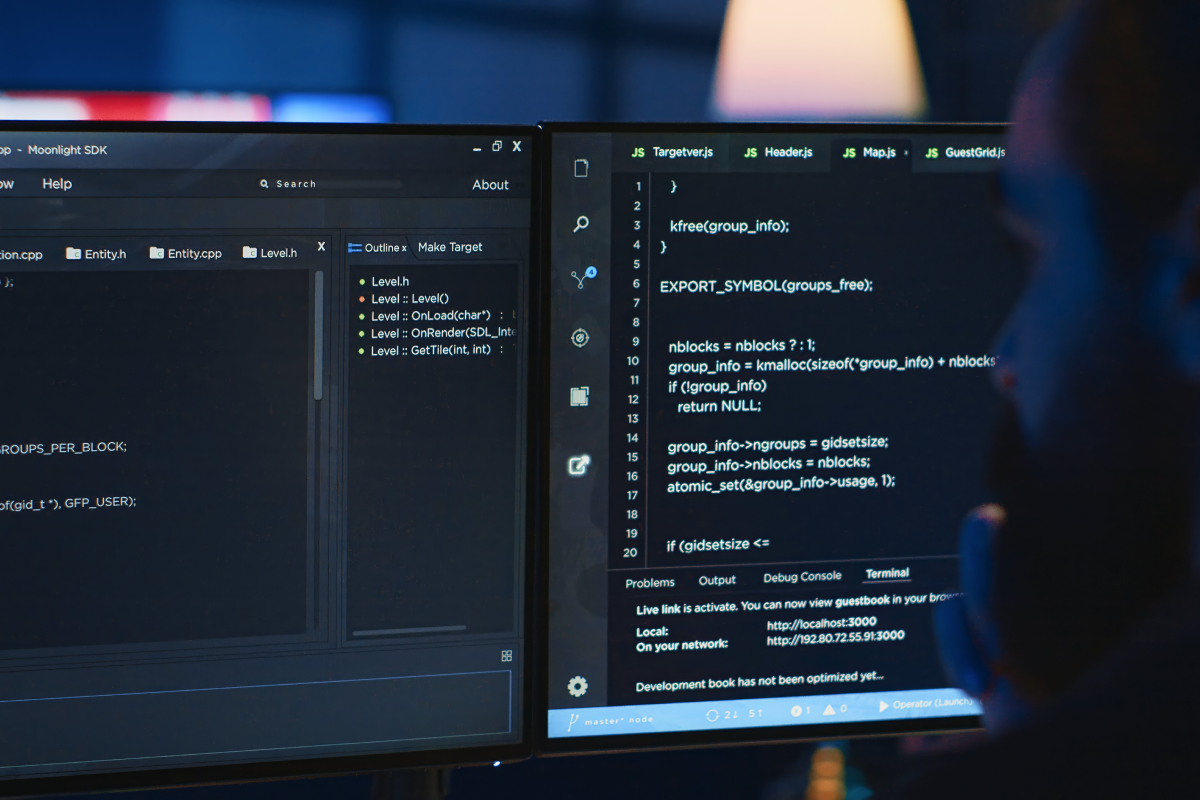For many years in a row, Javascript holds the credit of being the most popular programming language among developers. And that’s hardly a surprise! The scope of JavaScript use is so stunningly broad that you can use it to build almost anything: from a cookie-cutter website to complex server applications.
However, it has not always been like that. Not that long ago, JavaScript made its way from the browser to the server and became so versatile in its use cases. And the credits go to Node.js.
So what is so magical about Node.js? And how did it make JavaScript the programming language of choice for such big guns as Walmart and Linkedin? Here's the major question: where should you use Node.js to leverage its power? This article is here to answer all these questions.
What is Node.js?
Node.js is one of the most popular environments, taking the lead for the second consecutive year. While JavaScript is a programming language, Node.js is an ecosystem built on JS, leveraging the V8 – Google server engine. V8 uses the JavaScript code to translate it into a faster machine code, readable by a computer.
Before Node.js stepped in, JavaScript could only work in a browser for writing the frontend part of web-apps. Yet, using JavaScript for general-purpose applications was challenging. Rayan Dahl filled this gap in 2009 when he came up with a new environment to execute JavaScript separately from a web browser.
Since then, JavaScript has been used to make much more than simple websites and interactive web apps. It expanded its use to microcontrollers, REST APIs, static file servers, and even Internet of Things (IoT)!
How does Node.js work?
To better understand the revolutionary role of Node.js, it pays to outline the deficiencies of JavaScript had before.
The JS is a single-threaded system, which accepts all requests in one thread. This single thread handles everything that happens on the webpage: page scroll, listening to DOM events, printing something on the page, etc.
While one request is being processed, the server will not go on with another one. In this case, the execution will be blocked, and the browser will “freeze.”
Node.js applies a progressive event-driven pattern with an event-loop that replies to specific events. Thus, Node.js uses single-thread non-blocking I/O calls, which supports thousands of connections simultaneously.
Hence, Node.js make JS much more dynamic, bringing in the following novelties:
- I/O calls do not block the main thread;
- Server keeps processing user requests simultaneously;
Check out more about our Node.js Development Services
Pros of using Node.js
Well, you might have already realized that Node.js is the favorite for many programmers. And here is why exactly:
- Non-blocking I/O calls model
Node.js pros are manifold. But its ace of trumps is the event-based paradigm. When the server has thousands of connections simultaneously, the Node.js processes them in the priority order in one thread instead of spawning a new one. Such resource allocation allows for serving more users simultaneously.
- Simple and popular JavaScript language
Node.js is not a full-fledged programming language itself, but rather an environment for JavaScript execution. While having tools of its own, like native libraries, Node.js primarily uses JavaScript's abilities and syntaxes.
- V8 engine
V8 is an engine written in C++ and developed by Google for JavaScript performance optimization. The engine improves the performance by converting JavaScript language into machine code, readable by a computer. Thus, V8 engine is continuously evolving to speed up Web and Node.js ecosystem.
- Suits both front-end and back-end
Another advantage of Node.js is its universality. Node.js can be used as a single programming language for both front-end and back-end development. This simple feature makes a client's life easier, as it can be difficult to find a team of full stack programmers.
- Rich ecosystem
Thanks to the Node.js default package manager (npm), the framework provides a broad platform for JavaScript tools. What makes the Node.js ecosystem are the 836,000+ libraries available in the npm registry.
With such an amount of free resources available, Node.js is the most popular framework among developers.
Cons of using Node.js
Despite the broad scope of use-cases, Node.js still is not a plaster for all sorts of web development. Here are the vulnerabilities that Node.js brings with it:
- Node.js is not suitable for heavy CPU-bound request
Being a single-threaded JS runtime environment, Node.js executes tasks asynchronously. That means it starts a thread once a request comes in, processes it, and triggers a callback upon completion. If a heavy computation request comes along to the thread, it will take the whole CPU to process it before moving on to other queued tasks.
- Poor quality of some Node.js packages
While the main Node.js modules are supervised, some tools in the npm registry do not live up to this standard. This may make it challenging to figure out the best solution for your purposes and again negatively impact the code’s quality.

What is Node.js good for?
Node.js has significantly extended the use-cases of JavaScript. It is no surprise that such business giants as eBay, PayPal, and Netflix now use it for building their platforms. For one, Node.js is regarded as the native land of the Internet of Things, IoT. IoT devices like fitness trackers and thermostats can all be programmed with Node.js. Here are more common examples of how Node.js is used.
Data streaming
Data streaming means breaking large files into smaller batches to provide smooth and impeccable streaming. Node.js is perfect for such tasks, as it provides an application programming interface to work with streams and allows creating readable and writable data streams. For example, Netflix’s programmers chose Node.js for building their streaming platform.
Collaborative tools
Like in the previous example, this use case leverages Node.js' ability to manage several processes at the same time. The Trello example shows that Node.js comes in handy for applications where immediate updates and management of multiple processes are needed, such as team management programs and documentation suites.
Hardware programming
When we talk about hardware, we mean techs that are already taking a large part in our everyday lives – robots, drones, quadcopters, and other IoT devices.
Again, the ability of Node.js to perform several tasks simultaneously is the main reason it is so popular in this industry. With Node.js and the appropriate frameworks (Johnny-Five, Cylon.js), you have the opportunity to develop robots and JS-controlled devices like NodeBots.
What is Node.js is NOT good for?
CPU-heavy server-side computation
Although Node.js is versatile and powerful, heavy computations are not its strong point. It plunges the CPU into an intensive bout of number crunching, which blocks incoming requests from being processed.
CRUD apps
CRUD refers to apps related to either of the four categories (Create, Read, Update, Delete) that feature a relational database. Some years ago, building CRUD apps with Node.js could not be the best thing to do.
However, today there is a TypeORM – an object-relational mapping tool that supports the latest edition of JavaScript features and makes Node.js a more versatile programming language. Thanks to TypeORM, building CRUD apps of any complexity is not a problem anymore.

Summary
Among the multitude of frameworks, Node.js certainly takes the lead. Yet, though simple and widely used, the environment is only worth it when used correctly.
Uptech’s programmers have vast experience building complex platforms using Node.js environment. Our team is always on the lookout for new challenges. So do not hesitate to contact us if you have a promising idea on your mind.































.avif)







































